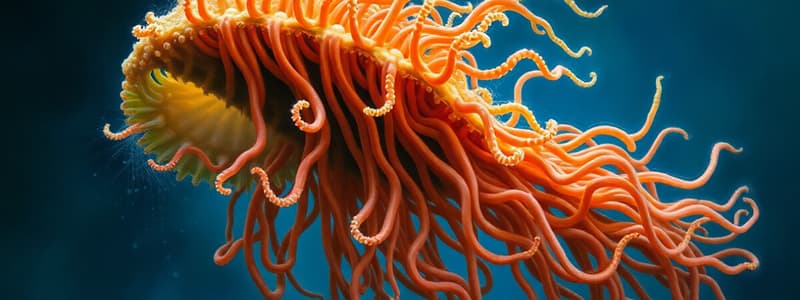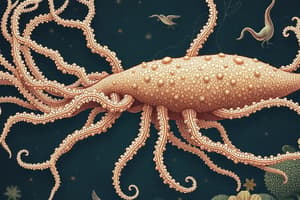Podcast
Questions and Answers
What does a polyphyletic group consist of?
What does a polyphyletic group consist of?
- Species with a common ancestor
- Species that share homologous traits
- Species that are all part of a single lineage
- Species from different ancestors with similar traits (correct)
Which of the following best describes the relationship of organisms within a polyphyletic group?
Which of the following best describes the relationship of organisms within a polyphyletic group?
- They exhibit homologous traits due to shared descent.
- They are all derived from a single common ancestor.
- They are related through multiple, unrelated ancestors. (correct)
- They are entirely unrelated with no common characteristics.
What characteristic differentiates a polyphyletic group from a monophyletic group?
What characteristic differentiates a polyphyletic group from a monophyletic group?
- Inclusion of species that lack a common ancestor (correct)
- Composition from a single lineage of descent
- Presence of homologous traits
- Shared lineal descent
Why might polyphyly be viewed as problematic in biological classification?
Why might polyphyly be viewed as problematic in biological classification?
Which of the following is NOT a characteristic of a polyphyletic group?
Which of the following is NOT a characteristic of a polyphyletic group?
What type of nervous system is primarily found in cnidarians?
What type of nervous system is primarily found in cnidarians?
Which statement accurately describes the nervous system in cnidarians?
Which statement accurately describes the nervous system in cnidarians?
What is a distinguishing feature of the cnidarian nervous system compared to humans?
What is a distinguishing feature of the cnidarian nervous system compared to humans?
In cnidarians, how do signals propagate through their nervous system?
In cnidarians, how do signals propagate through their nervous system?
Which characteristic of the cnidarian nervous system typically confuses students?
Which characteristic of the cnidarian nervous system typically confuses students?
What best describes how signals are directed in the cnidarian nervous system?
What best describes how signals are directed in the cnidarian nervous system?
What is a misconception regarding cnidarian nerve nets?
What is a misconception regarding cnidarian nerve nets?
Which of the following is NOT true about the cnidarian nervous system?
Which of the following is NOT true about the cnidarian nervous system?
What critical property of trees should biologists understand regarding their structure?
What critical property of trees should biologists understand regarding their structure?
What does the similarity 'Sister is Sister' imply in relation to the structure of groups?
What does the similarity 'Sister is Sister' imply in relation to the structure of groups?
Which term is used to describe the concept of maintaining simplicity in classification?
Which term is used to describe the concept of maintaining simplicity in classification?
What is a characteristic of branches in cladistics?
What is a characteristic of branches in cladistics?
How are the terms 'clean' and 'messy' relevant to the discussion of biological classification?
How are the terms 'clean' and 'messy' relevant to the discussion of biological classification?
What conclusion can be drawn from the statement that members of a group are 'closely related'?
What conclusion can be drawn from the statement that members of a group are 'closely related'?
In the context of cladistics, what does the term 'group' imply?
In the context of cladistics, what does the term 'group' imply?
What role does the concept of a pivot play in understanding biological trees?
What role does the concept of a pivot play in understanding biological trees?
Which hypothesis regarding the origin of animals is most supported by molecular evidence?
Which hypothesis regarding the origin of animals is most supported by molecular evidence?
What are the three body types found in sponges?
What are the three body types found in sponges?
How does the Asconoid body type differ from the other sponge body types?
How does the Asconoid body type differ from the other sponge body types?
In a Leuconoid sponge, what is the primary feature that distinguishes it from Asconoid sponges?
In a Leuconoid sponge, what is the primary feature that distinguishes it from Asconoid sponges?
Which statement correctly describes the relationship between sponges and their body types?
Which statement correctly describes the relationship between sponges and their body types?
What is the main function of choanocytes in sponges?
What is the main function of choanocytes in sponges?
How do sponges primarily obtain nutrients?
How do sponges primarily obtain nutrients?
What is a characteristic common to all types of sponge body plans?
What is a characteristic common to all types of sponge body plans?
Which form is primarily responsible for sexual reproduction in the context provided?
Which form is primarily responsible for sexual reproduction in the context provided?
What circumstance is necessary for the Polyp form to also reproduce sexually?
What circumstance is necessary for the Polyp form to also reproduce sexually?
Which of the following statements is true regarding the two forms mentioned?
Which of the following statements is true regarding the two forms mentioned?
What is one key characteristic of the Medusa form regarding reproduction?
What is one key characteristic of the Medusa form regarding reproduction?
Which statement about sexual reproduction in Medusa is correct?
Which statement about sexual reproduction in Medusa is correct?
Under what situation may the Polyp form engage in sexual reproduction?
Under what situation may the Polyp form engage in sexual reproduction?
Which statement is inaccurate regarding the reproductive forms discussed?
Which statement is inaccurate regarding the reproductive forms discussed?
What type of reproduction can the Polyp form perform?
What type of reproduction can the Polyp form perform?
Flashcards are hidden until you start studying
Study Notes
Cnidocyte Stinging Organelle
- Cnidocytes are specialized cells in cnidarians that contain a stinging organelle called a nematocyst.
- Nematocysts are used for defense and capturing prey.
Nervous System of Cnidarians
- Cnidarians have a decentralized nervous system called a nerve net.
- The nerve net lacks a centralized brain and allows for coordinated movements.
Reproduction in Cnidarians
- Cnidarians can reproduce both sexually and asexually.
- Medusa is the sexually reproductive stage, while polyps are asexual or can also reproduce sexually under certain conditions.
Polyphyletic Groups
- A polyphyletic group is a grouping of organisms that does not share a common ancestor.
- This type of grouping is considered messy, as there is no clear evolutionary relationship between its members.
Tree Pivoting and Branch Length
- Phylogenetic trees can be pivoted at any node without changing the relationships between the organisms.
- Branch length in a phylogenetic tree does not indicate the time since divergence, but rather the amount of evolutionary change.
Cladistics and Parsimony
- Cladistics is a method of classification based on shared derived characters, or synapomorphies.
- The principle of parsimony states that the simplest explanation is usually the most likely. In cladistics, this means that the phylogenetic tree with the fewest evolutionary changes is the most likely to be correct.
Origin of Animals
- The colonial flagellate hypothesis is the most supported hypothesis for the origin of animals.
- This hypothesis proposes that animals evolved from colonial protists with flagella.
Sponge Body Types
- There are three body types in sponges: asconoid, syconoid, and leuconoid.
- Asconoid: Simplest type, with a single central cavity called a spongocoel.
- Syconoid: More complex, with folded body wall creating chambers and canals.
- Leuconoid: Most complex, with a highly branched canal system that increases surface area for filter feeding.
Studying That Suits You
Use AI to generate personalized quizzes and flashcards to suit your learning preferences.




